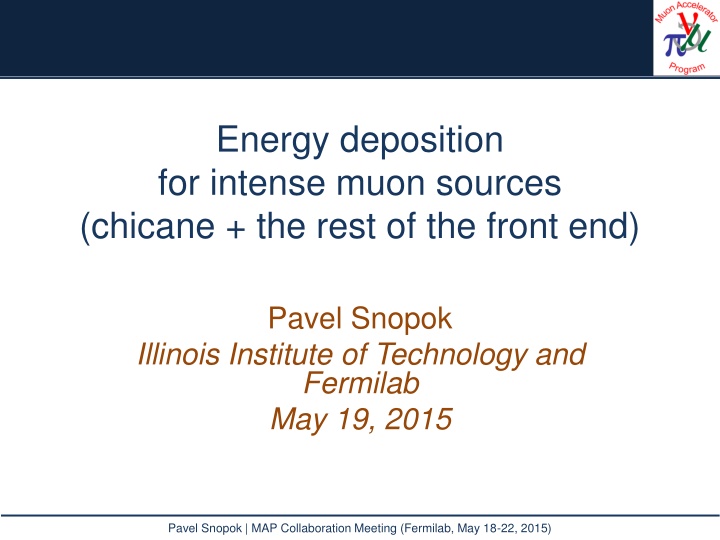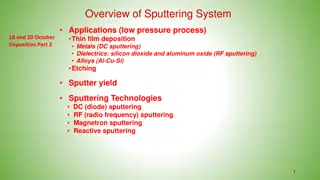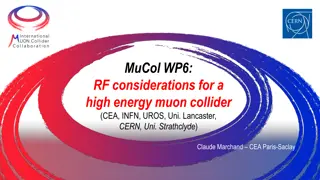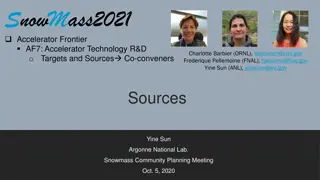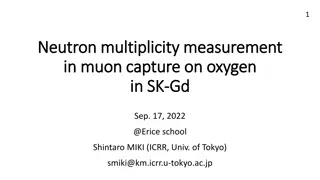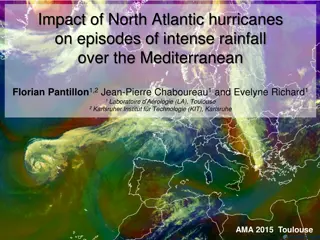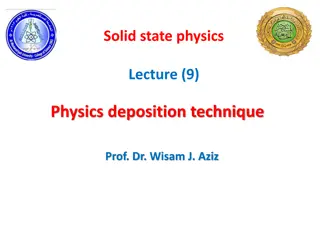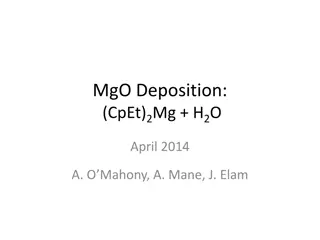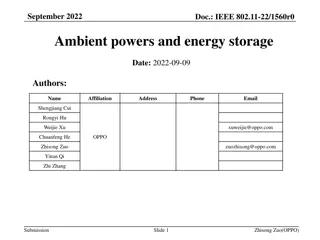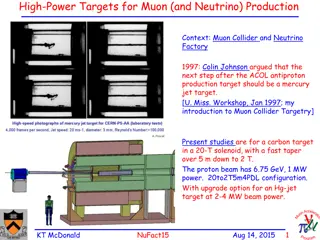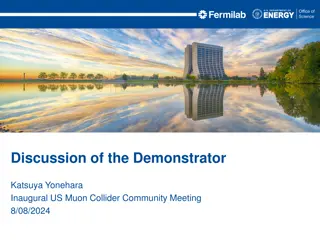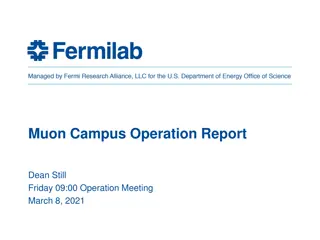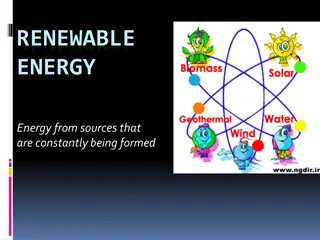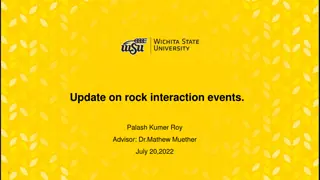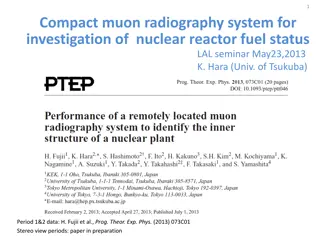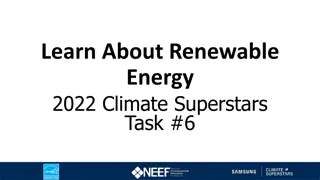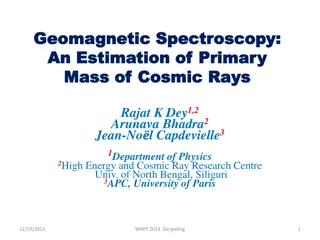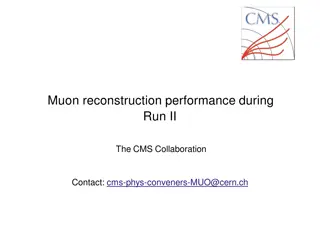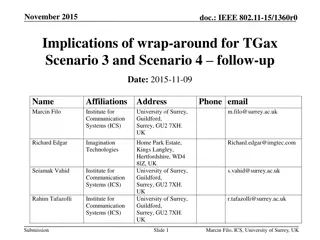Energy Deposition for Intense Muon Sources: Power Challenges and Solutions
Exploring the power deposition challenges and solutions for intense muon sources, focusing on the power deposited per unit length and the need for a secondary particle handling system. The history of MARS simulations and key insights from simulations based on the hybrid channel ICOOL lattice are discussed, along with references to address issues such as heat deposition on superconducting materials. Visualization of power deposition data and insights into mitigating risks are also covered.
Uploaded on Mar 19, 2025 | 2 Views
Download Presentation

Please find below an Image/Link to download the presentation.
The content on the website is provided AS IS for your information and personal use only. It may not be sold, licensed, or shared on other websites without obtaining consent from the author.If you encounter any issues during the download, it is possible that the publisher has removed the file from their server.
You are allowed to download the files provided on this website for personal or commercial use, subject to the condition that they are used lawfully. All files are the property of their respective owners.
The content on the website is provided AS IS for your information and personal use only. It may not be sold, licensed, or shared on other websites without obtaining consent from the author.
E N D
Presentation Transcript
Energy deposition for intense muon sources (chicane + the rest of the front end) Pavel Snopok Illinois Institute of Technology and Fermilab May 19, 2015 Pavel Snopok | MAP Collaboration Meeting (Fermilab, May 18-22, 2015)
Outline Introduction History Current MARS simulations based on the hybrid channel ICOOL lattice Summary 3/19/2025 Pavel Snopok | MAP Collaboration Meeting (Fermilab, May 18-22, 2015) 2
Introduction Power deposited per unit length [kW/m] 0.01 0.1 10 1 0 50 100 z [m] 150 200 e+ and e- m+ and m- proton 250 In high-intensity sources muons are produced by firing high energy p onto a target to produce . decay to which are captured and accelerated. Significant background from p and , which may result in heat deposition on superconducting materials; activation of the machine preventing manual handling. 3/19/2025 Pavel Snopok | MAP Collaboration Meeting (Fermilab, May 18-22, 2015) 3
Introduction, contd. Need a secondary particle handling system for a megawatt class solid C target solenoidal chicane followed by a proton absorber. Challenges of optimization and integration of the system with the rest of the muon front end. Main study tool MARS, some analysis and validation by using ICOOL and G4beamline. Use the same technique to study the buncher/phase-rotator/cooler for the hybrid channel. 3/19/2025 Pavel Snopok | MAP Collaboration Meeting (Fermilab, May 18-22, 2015) 4
History: MARS simulations ROOT-based geometry 12.5 single bend, Z=0 corresponds to 19 m downstream of the target consistent with RDR (IDS-NF). W density reduced to 60% to take into account packing fraction for beads. 5
Reference: no shielding DPD peaks at 15.8 mW/g, that translates into 42.6 kW/m for Cu coils or 33.3 kW/m for SC coils. 3/19/2025 Pavel Snopok | MAP Collaboration Meeting (Fermilab, May 18-22, 2015) 6
Uniform 35 cm shielding PD total, mW/g Empty channel 7
Overall DPD per coil/segment Average DPD per coil, mW/g Segmented coil analysis, total DPD, mW/g In both cases red line corresponds to 0.1 mW/g SC limit 8
Ongoing MARS simulations New target parameters: 8 GeV => 6.75 GeV 4 MW => 1 MW 3.125e15 protons/sec => 0.925e15 protons/sec new particle distribution New ICOOL lattice file hybrid channel Looking downstream of the chicane buncher phase rotator matcher/cooler 3/19/2025 Pavel Snopok | MAP Collaboration Meeting (Fermilab, May 18-22, 2015) 9
MARS RF Challenge Stationary magnetic fields are straightforward Time-dependent electric field in the RF cavities is not. Ended up using a combination of the two user routines in MARS m1514.f intended for other purposes: MFILL = meant for producing data for histograms, knows when a region boundary is crossed. KILLPTCL = meant for killing particles under certain conditions, here one can change the energy/momentum of the particle RF is a kick approximation (at the center of the cavity). Use MARS extended geometry, and while it is sufficient, ROOT geometry would be much more convenient given the length and regularity of the structure. May 19, 2015 Pavel Snopok | MAP Collaboration Meeting (Fermilab, May 18-22, 2015) 10
MARS RF, first results A few tracks running through buncher/rotator/cooler. Magnetic field is a field map imported from G4beamline. Tracks lose energy in absorbers and gain energy when they cross the center of a cavity. May 19, 2015 Pavel Snopok | MAP Collaboration Meeting (Fermilab, May 18-22, 2015) 11
Other codes Once MARS lattice is up and running, the plan is to compare results with G4beamline/ICOOL energy loss calculations Back in 2010 I did a comparison of the two codes for IDR: Integrated losses per 8 GeV proton 0.1 0.2 0.3 0.4 0.5 0.6 0.7 0.8 0.9 0 1 0 g4bl: e+ and e- ICOOL: e+ and e- g4bl: p+ and p- ICOOL: p+ and p- g4bl: m+ and m- ICOOL: m+ and m- g4bl: proton ICOOL: proton 50 100 z [m] 150 200 250 3/19/2025 Pavel Snopok | MAP Collaboration Meeting (Fermilab, May 18-22, 2015) 12
Summary Buncher/rotator/cooler are in MARS now. More input on a more precise geometry for coils and cavities is appreciated. Kick approximation is used for RF cavities at the moment workaround style, something more straightforward and permanent would be good; information on phasing is taken directly from ICOOL, no reference particle(s) tracking in MARS. MARS is the main tool, although G4beamline and ICOOL are also used for some analyses, could be used for validation. 3/19/2025 Pavel Snopok | MAP Collaboration Meeting (Fermilab, May 18-22, 2015) 13
Thank you! 3/19/2025 Pavel Snopok | MAP Collaboration Meeting (Fermilab, May 18-22, 2015) 14
